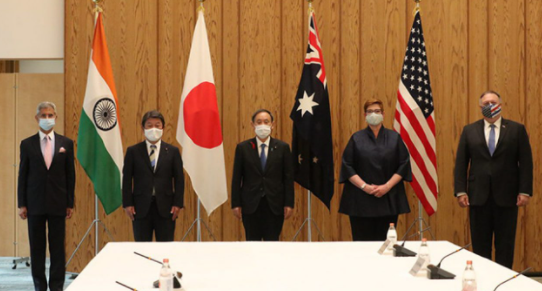Militarism is in the air in the Indo-Pacific. But it is important to keep the level of competition non-militaristic
United States (US) President Joe Biden is credited with taking the initiative for the summit-level meeting of Quad that took place on March 12. Prime Minister Narendra Modi, too, thanked Biden for taking this initiative in his opening comments at the summit. This is the second high-profile foreign policy initiative taken by Biden in his first 100 days in office. Earlier, he addressed the Munich Security Conference on February 19 where he tried to win back European allies such as Germany, France and the United Kingdom, by proposing a transatlantic alliance to counter China. However, the mood in the European Union (EU) is not for confrontation with China. Both the German Chancellor Angela Merkel and the French President Emmanuel Macron seemed less enthusiastic about taking on China directly.
To buy our online courses: Click Here
Biden’s next stop was Quad. Here too, his focus was to contain China. But he did not betray the aggression of his predecessor. The last time when the foreign ministers of Quad countries met in Tokyo, they could not even issue a joint statement, primarily because of the strident anti-China rhetoric of then US Secretary of State, Mike Pompeo. India was particularly reluctant to agreeing with the Obama-time vocabulary of “Free and Open Indo-Pacific — FOIP”. It insisted on adding another I — inclusive. India deserves credit that there was not only a joint statement this time, but it even stated that: “We strive for a region that is free, open, inclusive, healthy, anchored by democratic values, and unconstrained by coercion.”
Read More: Caution, Milords
The elephant in the room, China, could not be ignored. India’s insistence on an inclusive approach was in keeping with the sentiments of many smaller countries in the region, which may not take an explicit anti-China position. On the other hand, the Americans are clear about their containment policy. Both have met midway. The joint statement highlights maritime challenges in the region and calls for “collaboration, including in maritime security, to meet challenges to the rules-based maritime order in the East and South China Seas”. It is a clear indication of possible future joint action by Quad countries in the region, although India was never forthcoming about it in the past.
Quad may not be a full-scale alliance yet, but a new “minilateral” is taking shape. Quad’s immediate focus on vaccines and sharing of responsibility was welcomed by India. India is already supplying 60% of the world’s vaccines. The initiative will further boost its vaccine manufacturing capacity. This could also pave the way for India to become the manufacturing destination for Quad countries, thus reducing dependence on China. Quad partners such as Japan and Australia were unhappy over India’s decision to stay out of the Regional Comprehensive Economic Partnership. If Quad emerges as an economic powerhouse, it will be beneficial to the entire region.
The region has had several multilateral and minilateral alliances in the past. East Asia Summit (EAS), Aasen Security Forum, and the decades-old APEC are some of them. But these forums have become lazy talking shops without any discernible results. If Quad were to not go down that path, it should be willing to take the bull by its horns. The Indo-Pacific is heating up. A new Cold War has already started. Xi Jinping, the supreme leader of China, believes that time and momentum are on his side. He is flexing his military muscle aggressively.
The grand display of military might on the streets of Beijing on October 1, 2019, on the occasion of the 70th anniversary of the founding of the People’s Republic of China (PRC), was intended to send out a clear message about China’s military preparedness. China has built extensive infrastructure in the Indo-Pacific region from Djibouti to Kyaukpyu in Myanmar. Its Maritime Silk Road is as much strategic as economic. Its economic might is its potent weapon too.
In order to tackle a belligerent China, other countries are also actively upping their strategic activity in the region. The US has bases from Hawaii to Guam to Okinawa to Diego Garcia to Djibouti. Japan has a base in Djibouti and is increasingly seen patrolling in various Indo-Pacific sites. Australia has its outposts at Cocos and Christmas islands. It undertakes surveillance operations from Butterworth base in Malaysia and is also operationalizing its facility in Manus island of Papua New Guinea. France has its bases in Reunion and New Caledonia. Britain has Diego Garcia. India too is building ports in Chabahar, Chittagong, Colombo and Sitter. It has an agreement with Japan for access to its facility in Djibouti. India is also building a military base at the North Azalea island in Mauritius.
Lastly, Quad must keep in mind the warning given by the Singaporean Prime Minister Lee Hsien Loong: “Asia-Pacific countries do not wish to be forced to choose between the United States and China”.
Published in Hindustan Times on 15/03/2021. In this article “United States (US) President Joe Biden is credited with taking the initiative for the summit-level meeting of Quad .”





